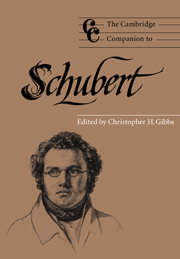Book contents
- Frontmatter
- Introduction: the elusive schubert
- Part I Contexts: musical, political, and cultural
- Part II Schuberts music: style and genre
- Part III Reception
- 13 German reception: Schubert's “journey to immortality”
- 14 Schubert's reception history in nineteenth-century England
- 15 Schubert's reception in France: a chronology (1828–1928)
- 16 Franz Schubert's music in performance: a brief history of people, events, and issues
- Notes
- Index
16 - Franz Schubert's music in performance: a brief history of people, events, and issues
from Part III - Reception
Published online by Cambridge University Press: 28 September 2011
- Frontmatter
- Introduction: the elusive schubert
- Part I Contexts: musical, political, and cultural
- Part II Schuberts music: style and genre
- Part III Reception
- 13 German reception: Schubert's “journey to immortality”
- 14 Schubert's reception history in nineteenth-century England
- 15 Schubert's reception in France: a chronology (1828–1928)
- 16 Franz Schubert's music in performance: a brief history of people, events, and issues
- Notes
- Index
Summary
The history of music in performance relies on a variety of resources: studies in the evolution of instruments, ensembles, and voices; the evidence of autographs, editions, proofs, marginalia, parts, books, diaries, and letters; tutors and related writings by teachers and performers over the years; and the documentation of concert life in programs and reviews. And since the 1890s, modern performance history has been revealed through a massive archive of recordings.
Schubert research, however, is somewhat disadvantaged in all of these areas except the last. Although we know much about the instruments and ensembles of his day, that information is not specific to Schubert. And of the hundreds of performance tutors published during or since Schubert's time (and now seldom read), few even mention his name. Until the first critical edition (ASA) began to appear in the 1880s his works were published piecemeal and poorly, and many autographs and other source materials went missing. During Schubert's lifetime, and for many years after his death, his music – especially his instrumental music – was championed by a mere handful of performers. For this reason, few pedagogical lines or performance traditions accumulated until late in the nineteenth century.
The only reliable body of evidence we have concerning Schubert in performance is the recordings. Somewhere around 1900 the recording industry discovered the saleability of certain pieces in the Schubert repertory: short works were tailored to match the capacity of the disc (Ave Maria, Erlkönig, etc.), then longer ones (Der Hirt aufdem Felsen, piano character pieces), and finally large-scale instrumental pieces (chamber works and the last two symphonies).
- Type
- Chapter
- Information
- The Cambridge Companion to Schubert , pp. 270 - 283Publisher: Cambridge University PressPrint publication year: 1997
- 1
- Cited by



